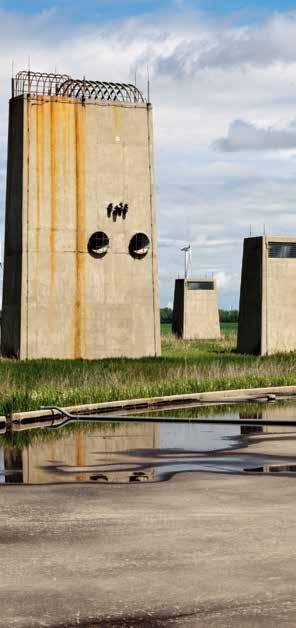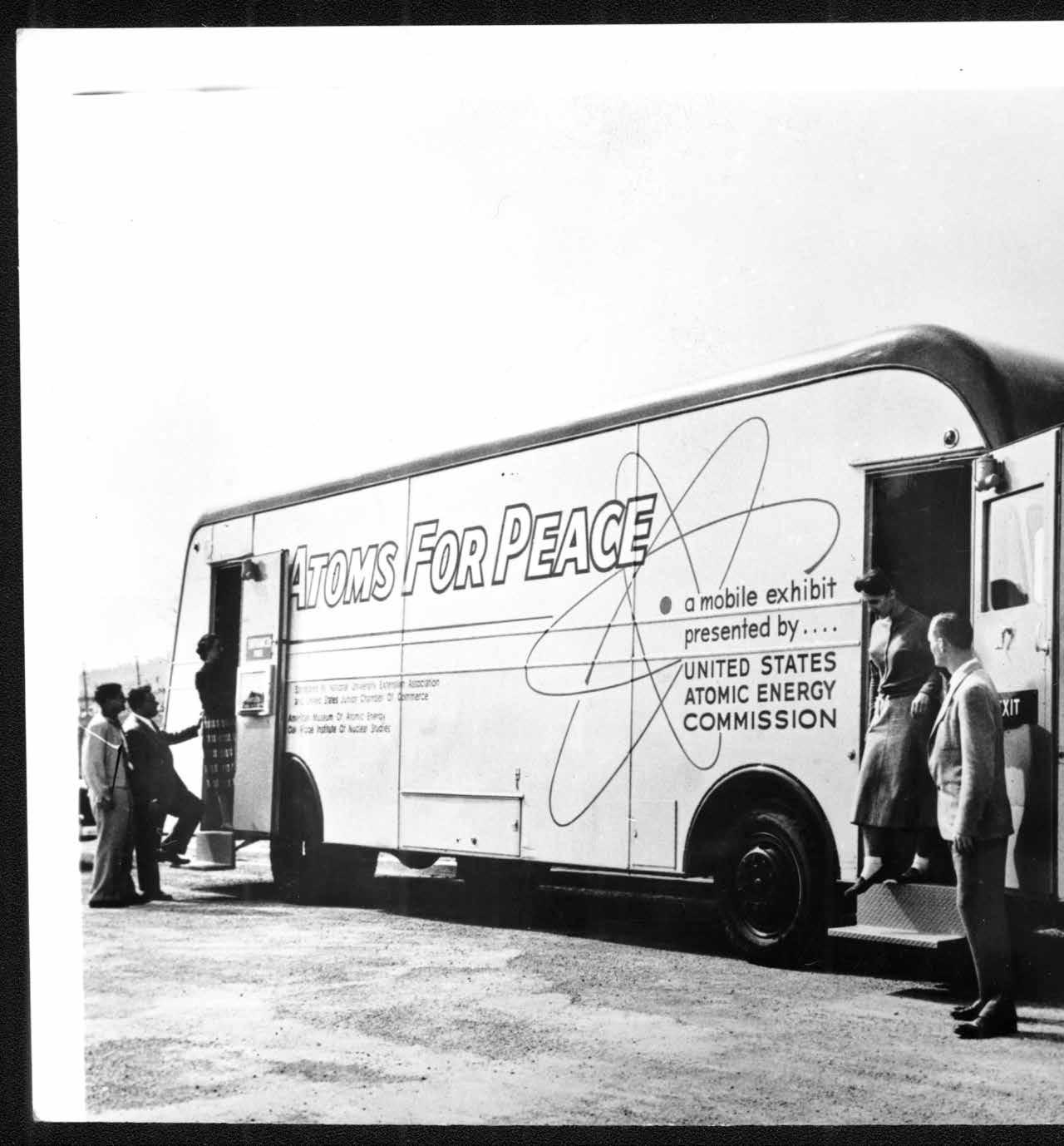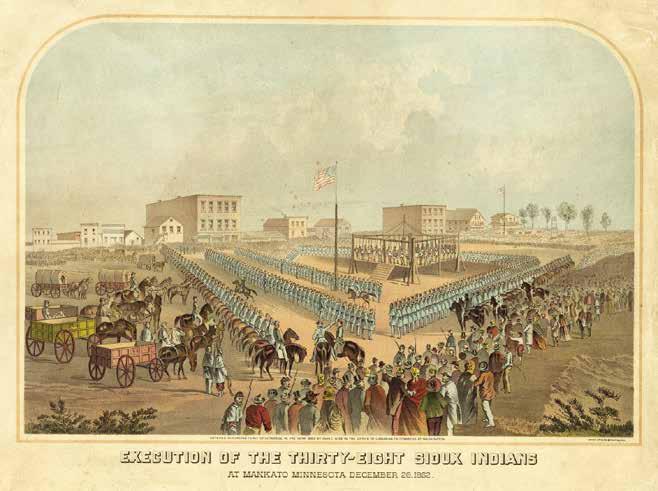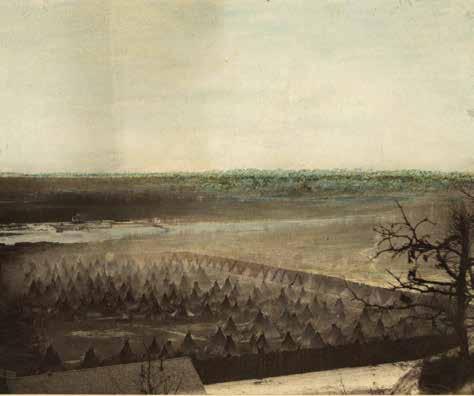
8 minute read
After Safeguard
Cover Photo: The Missile Site Radar, Nekoma, ND. © Maxime Brouillet Right: The exhaust stacks for the underground power plant. © Maxime Brouillet
By Marcel LaFlamme
Advertisement
I was seven years old when the Berlin Wall came down. I can still remember my father in his armchair, glued to the television screen. Restless, a little bored, I started up the stairs to my room, and he called me back: “No, you should see this. I know you don’t understand what you’re seeing right now, but someday you will, and you’ll be glad you saw it with your own eyes.”
What does it mean to watch the world change, to look on as a geopolitical order that has held sway for almost half a century begins to come unraveled? What does it mean to experience it through the hazy filter of childhood, as I did, or in history books, as do high school students today who have never lived in a world in which there was a Soviet Union? I still have a map tacked up on the wall at my parents’ house, the orange expanse of the USSR stretching from the Baltic Sea to the eastern edge of Siberia. But these days, more than twenty years after the Cold War ended and that map became obsolete, I am trying to locate myself within this history, to understand the claims that it makes on me and on the world that I have inherited.
My dissertation research on unmanned aviation brought me to North Dakota, a state that largely saw the Cold War, in historian David Mills’s argument, as an opportunity rather than a threat. While other parts of the United States balked at the arrival of military bases and missile fields, Mills’s forthcoming book shows that civic leaders in Fargo, Grand Forks, Bismarck, and Minot all vied for the federal dollars that would accompany these facilities—even though their arrival meant putting North Dakota in the crosshairs of a nuclear attack.
To defend against such an attack, Congress authorized the construction of the Stanley R. Mickelsen Safeguard Complex, an antiballistic missile installation built in the rural northeast corner of the state. Originally one of twelve sites to be built across the country, the Safeguard Complex in North Dakota was the only one to be completed after treaties signed in the early 1970s limited the proliferation of missile defense technology. The Missile Site Radar in Nekoma, with its signature concrete pyramid and its arsenal of Sprint and Spartan missiles, achieved full operational status on September 28, 1975. Four days later, in response to concerns about the system’s effectiveness and cost, the House of Representatives voted to deactivate it.
The photographs and interviews excerpted in this article are part of an ethnographic exhibition, staged in Cavalier County in November and December 2012, that documented the missile years and their aftermath in the small towns adjoining the Safeguard Complex. The construction of the site brought federal infrastructure investment and hundreds of new jobs to farming communities like Langdon, Nekoma, and Osnabrock, in a development boom that many current residents liken to the Oil Patch. Yet the site’s abrupt closure points to the ambivalent promise of development and the disruption it can leave in its wake. School enrollments plunged and businesses closed after the site went dark, and Cavalier County lost almost 40 percent of its population over the next two decades. “We were going to be different,” the former postmaster told me, “We were going to be a larger city.” This gap between what could have been and what is defines, at least in part, what it means to live even now in Safeguard’s shadow.
Contradictions abound. In interviews some say that the site personnel were welcomed into the community with open arms, while others confess that no one ever quite forgot who the missile people were. For Joan, the closing of the site was a relief, signaling a return to normalcy. For Nancy: “It was a sad time, after they said they were pulling the plug. It just tears you up. Because you feel like you own the darn thing sitting up there, like it’s yours.” Other incongruities are striking only to the outsider. In the middle of Langdon’s City Park, a leftover Spartan missile thrusts its way toward the sky. The kids at the nearby day care center like to hide between its tail fins.
Construction at Nekoma began in 1970, and the first wave of workers to arrive found housing wherever they could: in rented rooms, or in the new trailer park west of town. The manager of the rural electric cooperative remembers running wire out to old farmsteads that had been disconnected for years. Local farmers housed workers and enlisted them to help out with the farmwork, but they also hired on at the site to supplement their own incomes. “They were good jobs,” Carl recalls. “In ’70 or ’71, I don’t know what your minimum wage was, it was probably $1.30 or something. I know when I started working out there, it was $4.40 an hour and $1 an hour sub. Big money.” Some of that money got sent home to families or socked away as seed capital, but plenty of it also changed hands on rowdy weekend nights in downtown Langdon: ironworkers were known to gamble with the check number on their paystubs, and crowds of men would wander in and out of bars like the notorious Snake Pit.

The exhaust stacks for the underground power plant. © Maxime Brouillet Right: What’s green and what’s bare. © Maxime Brouillet
The tone shifts, in a way that’s unmistakably tied to class, when conversation turns to the second wave of new arrivals: army officers and defense contractors from firms like Raytheon and Martin Marietta, many with their families in tow. These career professionals lived in base housing out at the Safeguard site, where amenities from a beauty salon to a bowling alley had been added to meet their daily needs. An invitation to an event at the officers’ club became a mark of social distinction for civilians in town, who would often chuckle about the strange notions held by their new neighbors. Ruth remembers a Christmas party at which she realized that all of the missile wives were wearing long johns under their evening gowns. The North Dakota winters called for other adjustments, too: underground sensors along the patrol road would get triggered by the weight of the snow, and the military police would have to hurry out to make sure that there was no intruder. Despite these misunderstandings, friendships were formed and relationships kindled between local residents and the more recent arrivals. As Diane put it: “The missiles brought me here, but it was love that kept me here.”
Living in post-9/11 America means knowing a thing or two about how fear can leach into everyday life: the color-coded threat levels rising and falling, the impassive gaze of the TSA agent, the heightened scrutiny on anyone brown or, God forbid, Muslim. Yet what might be hardest for me to understand about life in Cavalier County during the missile years is the specter of nuclear war, made imminent in the built environment. How could you spot the pyramid on the horizon or drive by the remote Sprint site off Highway 5 and not think about the warheads glowing in their silos, ready to be launched on fifteen minutes’ notice? “Well, that was Dad’s job,” Nancy explained, “and so you didn’t worry about it. You just had faith that the defenses were going to work. If anything happened, it was going to be way outside, out there in the atmosphere. You just, you can’t worry about things like that.” There were some, of course, who did worry, including the student protesters that descended on Nekoma as construction was beginning in May 1970. Yet locals shied away from involvement with the protest, despite (or perhaps because of) their direct experience of the arms race.
Some say that it came as a shock; others insist that they saw it coming. Regardless, the closure of the Safeguard Complex marked the end of an era in Cavalier County. “Things went on,” Carl told me, haltingly. “But it was a lot less people around here then.” The contractors moved on to their next assignments, the trailer courts were dismantled, and salvage crews showed up at the site to strip out what they could. Then, for fifteen years, the Safeguard Complex sat empty. The current caretaker remembers how eerie it was to walk through the abandoned buildings for the first time in 1991: “It was just like somebody hollered ‘run.’” The buildings, today, are in reasonably good repair, and this past December the site was sold for $530,000 to an unknown bidder. Part of me, naturally, wants to see someone breathe new life into the place, to create some jobs that would retain the area’s young people and diversify the local economy. But another part of me is fascinated by the Safeguard Complex as a ruin, as a materialization of the death drive that brought our civilization to the brink of destroying itself. The peeling wallpaper, the overgrown creek, the wind whistling in my ears out on the missile field: all of these have made the Cold War more real to me than those flickering images of the Berlin Wall ever could.
For Cavalier County, the takeaway may be different. Anthropologist Catherine Lutz called into question the assumption that military installations are an economic boon for their host communities, while her colleague David Vine has pointed to the destabilizing effects of the more than 1,000 bases that the United States presently maintains overseas. Indeed, here in North Dakota, it wasn’t just hippies who opposed the construction of the Safeguard Complex: Governor William Guy and Senator Quentin Burdick were on record as opposing it, too. None of this is meant to detract from the patriotism and ingenuity of those who built the Safeguard site, or of those who serve in uniform today. But it is to put pressure on the uneasy relationship between global militarism and local prosperity, and to ask how sustainable development can be when the key decisions are being made half a continent away. As Cavalier County wrestles with the legacy of the Cold War, as its residents debate what comes after Safeguard, these are questions that will be impossible to avoid.
NB: Following anthropological convention, interviewees in this article are identified with pseudonyms.
Marcel LaFlamme is a graduate student in the Department of Anthropology at Rice University in Houston, Texas. Before embarking on his doctoral studies, he served as the library director for a rural community college in southeast Kansas. He will be moving to Grand Forks in May to begin his dissertation research on unmanned aircraft testing and training.







